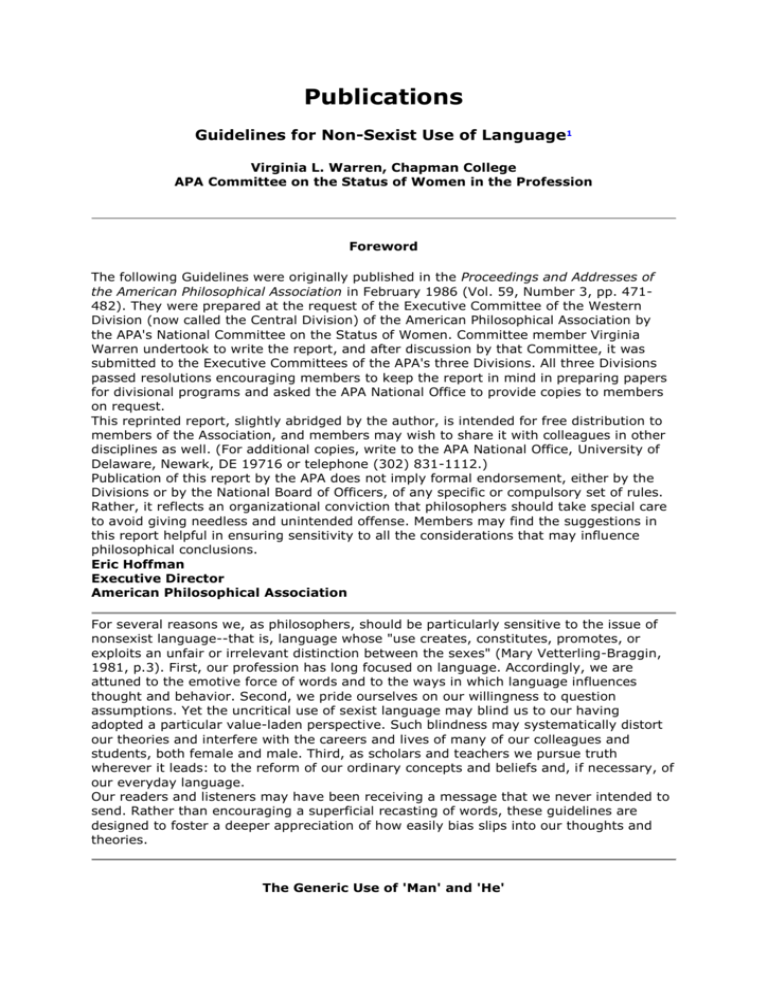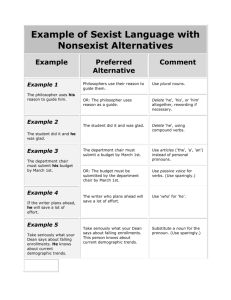
Publications
Guidelines for Non-Sexist Use of Language1
Virginia L. Warren, Chapman College
APA Committee on the Status of Women in the Profession
Foreword
The following Guidelines were originally published in the Proceedings and Addresses of
the American Philosophical Association in February 1986 (Vol. 59, Number 3, pp. 471482). They were prepared at the request of the Executive Committee of the Western
Division (now called the Central Division) of the American Philosophical Association by
the APA's National Committee on the Status of Women. Committee member Virginia
Warren undertook to write the report, and after discussion by that Committee, it was
submitted to the Executive Committees of the APA's three Divisions. All three Divisions
passed resolutions encouraging members to keep the report in mind in preparing papers
for divisional programs and asked the APA National Office to provide copies to members
on request.
This reprinted report, slightly abridged by the author, is intended for free distribution to
members of the Association, and members may wish to share it with colleagues in other
disciplines as well. (For additional copies, write to the APA National Office, University of
Delaware, Newark, DE 19716 or telephone (302) 831-1112.)
Publication of this report by the APA does not imply formal endorsement, either by the
Divisions or by the National Board of Officers, of any specific or compulsory set of rules.
Rather, it reflects an organizational conviction that philosophers should take special care
to avoid giving needless and unintended offense. Members may find the suggestions in
this report helpful in ensuring sensitivity to all the considerations that may influence
philosophical conclusions.
Eric Hoffman
Executive Director
American Philosophical Association
For several reasons we, as philosophers, should be particularly sensitive to the issue of
nonsexist language--that is, language whose "use creates, constitutes, promotes, or
exploits an unfair or irrelevant distinction between the sexes" (Mary Vetterling-Braggin,
1981, p.3). First, our profession has long focused on language. Accordingly, we are
attuned to the emotive force of words and to the ways in which language influences
thought and behavior. Second, we pride ourselves on our willingness to question
assumptions. Yet the uncritical use of sexist language may blind us to our having
adopted a particular value-laden perspective. Such blindness may systematically distort
our theories and interfere with the careers and lives of many of our colleagues and
students, both female and male. Third, as scholars and teachers we pursue truth
wherever it leads: to the reform of our ordinary concepts and beliefs and, if necessary, of
our everyday language.
Our readers and listeners may have been receiving a message that we never intended to
send. Rather than encouraging a superficial recasting of words, these guidelines are
designed to foster a deeper appreciation of how easily bias slips into our thoughts and
theories.
The Generic Use of 'Man' and 'He'
The generic use of 'man' and 'he' (and 'his', 'him', 'himself') is commonly considered
gender-neutral. The case against the generic use of these terms does not rest on rare
instances in which they refer ambiguously to 'male' or 'human being'. Rather, every
occurrence of their generic use is problematic.
First, Janice Moulton persuasively argues, in "The Myth of the Neutral 'Man'" (in
Vetterling-Braggin, 1981, pp. 100-115; revised from Vetterling-Braggin, et al, 1977, pp.
124-37), that 'he' and 'man' used generically are really not gender-neutral terms at all.
('Person' and 'human' are genuinely gender-neutral.) As evidence, Moulton offers many
examples of statements in which 'man' and 'he' unambiguously refer to all humanity,
rather than to males alone, yet are false, funny, or insulting. For example, "Some men
are female" is irredeemably odd, while "Some human beings are female" is fine.
Similarly, "Each applicant is to list the name of his husband or wife" is odd; and even
using "his spouse" disquiets more than using "his or her spouse."
Second, empirical evidence supports Moulton's claim that regardless of the author's
intention the generic 'man' is not interpreted gender neutrally.2 Casey Miller and Kate
Swift (1976) cite a study in which college students chose pictures to illustrate chapters of
a sociology textbook. Those with chapters entitled "Society," "Industrial Life," and
"Political Behavior" tended to select pictures of both females and males. However, when
the same chapters were named "Social Man," "Industrial Man," and "Political Man,"
students of both sexes tended to select pictures of males only. With some chapters the
differences [between the two groups] reached magnitudes of 30 to 40 percent. The
authors concluded, "This is rather convincing evidence that when you use the word man
generically, people do tend to think male, and tend not to think female" (Miller and Swift,
1976, p. 21). This study also finds that the generic 'man' leaves out more than women:
"As the image of capitalist, playboy, and hard hat are called forth by the word 'man', so
is the other side of the coin called forth by 'behavior' or 'life'--women, children,
minorities, dissent and protest" (Miller and Swift, 1976, p. 23).
Third, using the generic 'he' and 'man' is problematic because it often leads us to omit
the distinctive elements of female experience and behavior. For example, a sentence
beginning, "If a student is conscientious, he is probably a good . . . ," will likely be ended
with "son"--even though "good son," "good daughter," and "good child" connote different
things. If the sentence had begun, "A conscientious student is probably a good . . . ," a
likely finale would be "son or daughter" or "child."
In sum, there are convincing reasons, both empirical and conceptual, for avoiding the
generic 'he' and 'man' and for specifically including females. Hence, it is inadequate to
state in an opening footnote that, for the remainder of the letter, article or book, 'he'
shall stand for 'he or she' and 'man' for all humanity. What authors intend is not the
issue. Good intentions not carried through are not good enough.
Addressing the Professional
Forms of address indicate attitudes about status and/or worth. Children often go by first
names while calling adults by surname and title. Whenever males are referred to by title,
use the appropriate title for female professionals (Ms., Dr., Professor), rather than their
first names.
Sexual Stereotyping: Distortions and Silence
One way that sexual stereotypes enter philosophic discourse is through examples. Since
philosophic examples are usually illustrative, it is often thought that their presuppositions
need not be checked for sexist content. However, examples may manifest sexist bias: (a)
through embodying explicit or implicit sexual stereotypes (e.g., by contrasting female
beauty with male success, or by using this hackneyed example of complex question:
"When did you stop beating your wife?"); (b) through adopting a male perspective (as
when using the generic 'man' or 'he' leads one to say "his wife"); and (c) through
silence--the absence of examples explicitly referring to women.
A second mode of entry for sexual stereotypes has been through the labeling of some
roles as predominantly male or female. To assume that all lawyers or epistemologists are
male deletes the female segment of the profession and reinforces the assumption that
only males are "proper" professionals. Moreover, to assume that homemaking and child
rearing tasks are the primary concern of all and only women excludes males from these
roles, even as it ignores women's other concerns.
Finally, omitting women's distinctive interests and experience also perpetuates sexual
stereotypes. The generic use of 'he' and 'man' are part of the more general problem of
women's "invisibility" in philosophic discourse. Some empirical data on sexist language
indicate that if women are not specifically included (e.g., through using females in
examples, or the term "he or she"), even genuinely gender-neutral prose (e.g., using
plural pronouns) tends to be heard as referring to males only.3
Summary of Guidelines for the Nonsexist Use of Language
When constructing examples and theories, remember to include those human activities,
interests, and points of view which traditionally have been associated with females.
Eliminate the generic use of 'he' by:
using plural nouns
deleting 'he', 'his', and 'him' altogether
substituting articles ('the', 'a', 'an') for 'his'; and 'who' for 'he'
substituting 'one', 'we', or 'you'
minimizing use of indefinite pronouns (e.g., 'everybody', 'someone')
using the passive voice [use sparingly]
substituting nouns for pronouns [use sparingly]
Eliminate the generic use of 'man':
for 'man', substitute 'person'/'people', 'individual(s)', 'human(s)', 'human being(s)'
for 'mankind', substitute 'humankind', 'humanity', 'the human race'
for 'manhood', substitute 'adulthood', 'maturity'
delete unnecessary references to generic 'man'
Eliminate sexism when addressing persons formally by:
using 'Ms' instead of 'Miss' or 'Mrs.', even when a woman's marital status is
known4
using a married woman's first name instead of her husband's (e.g., "Ms.
Annabelle Lee" not "Mrs. Herman Lee")
using the corresponding title for females ('Ms.', 'Dr.', 'Prof.') whenever a title is
appropriate for males
using 'Dear Colleague' or 'Editor' or 'Professor', etc. in letters to unknown persons
(instead of 'Dear Sir', 'Gentlemen')
Eliminate sexual stereotyping of roles by:
using the same term (which avoids the generic 'man') for both females and males
(e.g., 'department chair' or 'chairperson'), or by using the corresponding verb
(e.g., 'to chair')
not calling attention to irrelevancies (e.g., 'lady lawyer', 'male nurse') 5
Example of Sexist Language with Nonsexist Alternatives
Example
Preferred Alternative
Comment
Example 1
The philosopher uses his
reason to guide him.
Philosophers use their
reason to guide them.
Use plural nouns.
OR: The philosopher
uses reason as a guide.
Delete 'he', 'his', or 'him'
altogether, rewording if
necessary.
The student did it and
was glad.
Delete 'he', using compound
verbs.
The department chair
must submit a budget
by March 1st.
Use articles ('the', 'a', 'an')
instead of personal pronouns.
OR: The budget must be
submitted by the
department chair by
March 1st.
Use passive voice for verbs.
(Use sparingly.)
The writer who plans
ahead will save a lot of
effort.
Use 'who' for 'he'.
Take seriously what
your Dean says about
falling enrollments. This
person knows about
Substitute a noun for the
pronoun. (Use sparingly.)
Example 2
The student did it and
he was glad.
Example 3
The department chair
must submit his budget
by March 1st.
Example 4
If the writer plans
ahead, he will save a lot
of effort.
Example 5
Take seriously what your
Dean says about falling
enrollments. He knows
about current
demographic trends.
current demographic
trends.
Example 6
As someone grows older,
he grows more
reflective.
As one grows older, one
grows more reflective.
Use 'one', 'you', 'we', instead of
indefinite pronouns.
OR: In growing older,
people grow more
reflective.
Or reword, deleting pronouns
altogether.
CONTROVERSIAL (FOR
INFORMAL CONTEXTS
ONLY): As someone
grows older, they grow
more reflective.
The National Council of
Teachers of English (1975, p. 3)
says, "In all but strictly formal
usage, plural pronouns have
become acceptable substitutes
for the maculine singular"
following an indefinite pronoun.
Kett and Underwood (1978, p.
38) predict that such informal
usage will eventually become
acceptable in all contexts.
Students are different:
one may relate to
others assertively, while
another may approach
the world timidly.
Delete 'his', rewording.
OR: Students are
different: one may be
assertive in his or her
interpersonal relations,
while another may be
timid in approaching the
world.
Use 'he or she, 'his or her'
sparingly, in conjunction with
other methods. ('Himself or
herself' is awkward. 'S/he'
breaks down when one come to
'her/his'.) 'She or he' and 'her
or him' are fine. Be consistent:
do not begin by using 'he or
she' and lapse into the generic
'he'. Avoid 'he (she)', 'men (and
women)', etc., since including
females parenthetically
suggests that females are an
afterthought.
Example 7
Students are different:
one may be assertive in
his interpersonal
relations, while another
may be timid in his
approach to the world.
OR: Students are
different: one may be
assertive in her
interpersonal relations,
while another may be
timid in his approach to
the world.
Alternate masculine and
feminine pronouns when giving
examples. (CAUTION: avoid
reinforcing sexual stereotypes.
Switching 'her' and 'his' in the
preferred alternative results in a
sentence as sexist as the
original.).
Example 8
"When a nurse comes on
duty she. . ." is as sexist
as "When a physician
comes on duty he. . ."
Use the above methods to avoid
the generic 'she' for traditionally
female occupations.
Example 9
Consider what the
ordinary (common) man
thinks about justice.
Consider what ordinary
people (individuals)
think about justice.
Using the plural noun avoids the
generic 'he' later on.
Reason is what
distinguishes humans
(human beings) from
other animals.
When 'man' is used to contrast
species, substitute 'humans' or
'human beings'. Use 'who' for
'he'.
Aristotle regarded
human beings as
inherently political.
No nonsexist counterparts to
'Political Man', 'Economic Man',
etc. preserve the exact flavor of
these terms-perhaps because
they focus on stereotypically
male behavior. Note that much
of 'Economic Woman's' labor is
still unpaid, and hence is
excluded from the G.N.P. Sexist
language may camouflage a
theory's sexist assumptions.
Example 10
Reason is what
distinguishes man from
other animals.
Example 11
For Aristotle, man is,
above all, Political Man.
Example 12
the brotherhood of
man
the human family
feelings of brotherhood
or fraternity
feelings of kinship,
solidarity, affection
collegiality, unity,
congeniality, community
the Founding Fathers
the Founders (founding
leaders)
the Father of relativity
theory
the founder (initiator) of
relativity theory
Example 13 - Salutations in Business Letters
Dear Sir, Gentlemen
(to an unknown person)
Dear Colleague, Dear
Editor, Dear Professor,
Dear Staff Member, etc.
Dear Sir, Dear Mr.
Green (when first name
and sex are unknown)
Dear Professor (Doctor,
Editor) Green, Dear J.
Green
Do not presume that people are
male until proven otherwise. Do
not use 'Dear Sir' or
'Gentlemen' just because you
are sure that there are no
women on that committee. If
'To Whom it May Concern'
seems too brusque and all else
fails, adopt a modified memo
style ('Attention: Order
Department') or omit the
salutation entirely.
Dear Mrs. Green (when
a female's marital status
is unknown)
Dear Ms. Green, Dear J.
Green, Dear Jean Green
Do not presume that women are
married until proven otherwise.
Example 14
man and wife
husband and wife
men . . . ladies; or
men . . . girls
men . . . women
three male students
and two coeds
five students (two
females and three
males)
Example 15
Of course, if the ages are
right,'men . . . girls' may be
appropriate, as may 'women . .
. boys'.
males and females
females and males
husbands and wives
wives and husbands
men and women
women and men
sons and daughters
daughters and sons
descendants of Adam
and Eve
descendants of Eve and
Adam
his and her
her and his
Varying the order (if the content
does not require the
conventional order) both
counters the implication that
males take priority over
females, and enlivens discourse
by avoiding cliche.
Example 16
Congressman,
Congresswoman
U.S. Representative,
member of Congress
Choose nonsexist labels for
occupations.
poetess, stewardess,
fireman, lady lawyer,
male nurse, woman
doctor
poet, flight attendant,
firefighter, lawyer,
nurse, doctor
The terms 'lawyer', 'nurse' and
'doctor' include both males and
females.
Example 17 - Choice of Adjective*
cautious men and
timid women
cautious women and
men; cautious people;
timid men and women;
timid people
ambitious men and
aggressive women
ambitious men and
women; ambitious
people; aggressive
women and men;
aggressive people
Choose adjectives carefully.
Sometimes we intend to
attribute the same trait to
females and males; yet,
through choosing two
stereotyped adjectives, we
imply either that the two groups
have different traits or that
readers should evaluate the
same trait differently for
females and males. (Note:
some adjectives have a
different emotive or descriptive
meaning when predicated of
one sex or the other.)
* Example 17 is from American Psychological Association (1977). Back
Notes
1. I gratefully acknowledge that these guidelines were modeled on those of the
American Psychological Association (1977) and of the National Council of Teachers
of English (1975). I also wish to thank the members of the Committee on the
2.
3.
4.
5.
Status of Women in the Profession who offered many useful suggestions on earlier
drafts--especially Mary Varney Rorty, who chaired the Committee, and whose
enthusiam and carefully worded comments and examples guided this project from
the beginning. Back
Empirical studies are cited by Dale Spender (1980, pp. 152-54); and by Wendy
Martyna, "Beyond the 'He/Man' Approach: The Case for Nonsexist Language"
Signs, Spring 1980, pp. 482-93). Back
Janet Hyde reports, in "Children's Understanding of Sexist Language"
(Developmental Psychology, July 1984, pp. 697-706), that the stories elementary
school and college students told were about females 12% of the time when a cue
sentence used 'he', compared to 18% ('they') and 42% ('he or she'). Back
See Miller and Swift (1976, pp. 97-103) for the historical background of 'Ms.',
'Mrs.' and 'Miss'. See Vetterling-Braggin (1981, pp. 217-48) for a debate on the
use of 'Ms.': "Michael Levin, "Vs. Ms."; L. M. Purdy, "Against 'Vs. Ms.'"; and Alan
Soble, "Beyond the Miserable Vision of 'Vs. Ms.'" Back
To understand why 'lady lawyer' is objectionable, see Robin Lakoff, 1975, pp. 2026; and Carolyn Korsmeyer, "The Hidden Joke: Generic Uses in Masculine
Terminology" (in Vetterling-Braggin, 1981, pp. 122-24, 127-28; and in VetterlingBraggin, et al, 1977, pp. 144-46, 149-50). Back
Bibliography
"Guidelines for Nonsexist Language in APA [American Psychological Association]
Journals," American Psychologist, June, 1977, pp. 487-94. Single copy available
free (if a stamped, self-addressed envelope is enclosed) from: Publication Manual,
Change Sheet 2, American Psychological Association, 1200 Seventeenth Street,
N.W., Washington, DC 20036.**
"Guidelines for Nonsexist Use of Language in NCTE [National Council of Teachers
of English] Publication," November, 1975. Single copy available free from:
National Council of Teachers of English, 1111 Kenyon Road, Urbana, Illinois
61801.***
Kett, Merriellyn, and Underwood, Virginia. How to Avoid Sexism: A Guide for
Writers, Editors and Publishers. Chicago: Lawrence Ragan Communications, Inc.,
1978. The book to read if you want to avoid the generic 'he'. A seventy-page
chapter, including numerous practice exercises, is devoted to this subject.
Lakoff, Robin. Language and Woman's Place. New York: Harper & Row, 1975. A
classic on the subject by a linguist who examines the subtleties of language about
women and language used by women.
Miller, Casey, and Swift, Kate. The Handbook of Nonsexist Writing. New York:
Barnes and Noble, Harper & Row, 1980. The best all-around reference book on
the subject--to be kept next to your dictionary.
Miller, Casey, and Swift, Kate. Words and Women. Garden City, NY: Anchor
Press/Doubleday, 1976. A fascinating and thoroughly researched account of
historical and contemporary use of language concerning women)including the
generic 'he' and 'man', (first and last) names, and gender-specific terms.
Excellent.
Spender, Dale. Man Made Language. London: Routledge & Kegan Paul, 1980.
Spender gives a good summary and critique of the general literature on sexist
language (pp. 7-51), and discusses the history of the generic use of 'man' and 'he'
(pp. 147-60).
Vetterling-Braggin, Mary, ed. Sexist Language: A Modern Philosophical Analysis.
Totowa, NJ: Littlefield, Adams and Co., 1981. A thorough and lively exploration of
recent philosophical literature on sexist language. Topics include: the definition of
sexism and sexist language; the moral significance of using sexist language; the
generic 'he' and 'man'; 'Ms.'; a comparison of sexist and racist language.
Excellent.
Vetterling-Braggin, Mary, Elliston, Frederick A., and English, Jane, eds. Feminism
and Philosophy. Totowa, NJ: Littlefield, Adams and Co., 1977. This general
anthology on the philosophy of feminism has five articles on sexist language.
Bibliography Update
** The "Guidelines for Nonsexist Language in APA [American Psychological Association]
Journals," have undergone a revision and name change. The current version is known as
Guidelines to Reduce Bias in Language and appears on pages 54 through 60 of the
Publication Manual of the American Psychological Association, 4th edition (1994). Single
copies are no longer available. Back
*** The "Guidelines for Nonsexist Use of Language in NCTE [National Council of Teachers
of English] Publication," have been revised as of 1985. They are still available from the
NCTE at a cost of $.75 for members and $1.00 for non-members. Back
http://www.apa.udel.edu/apa/publications/texts/nonsexist.html









